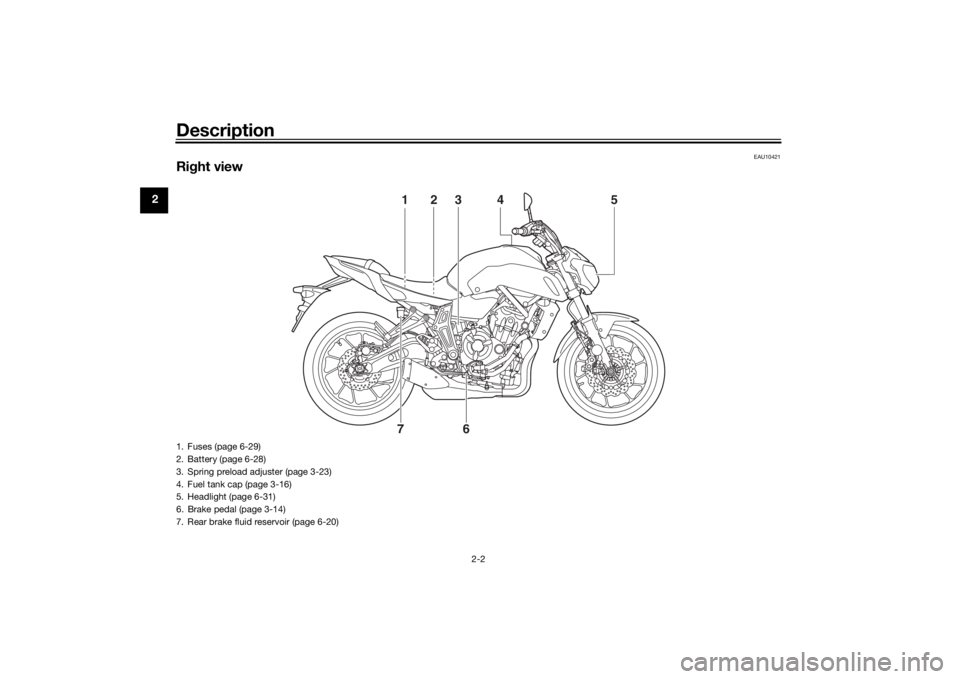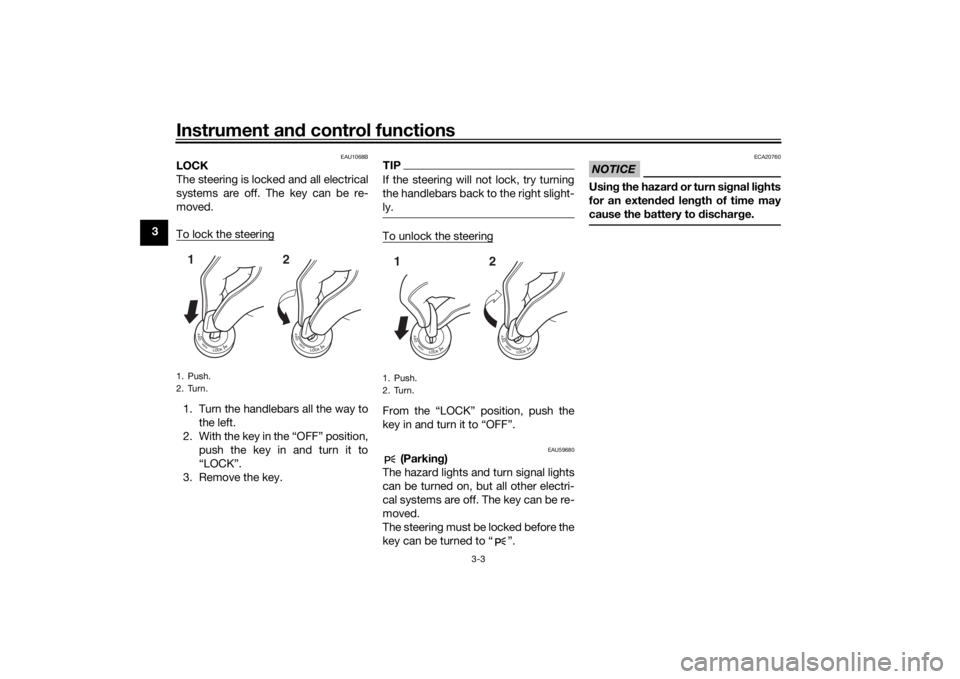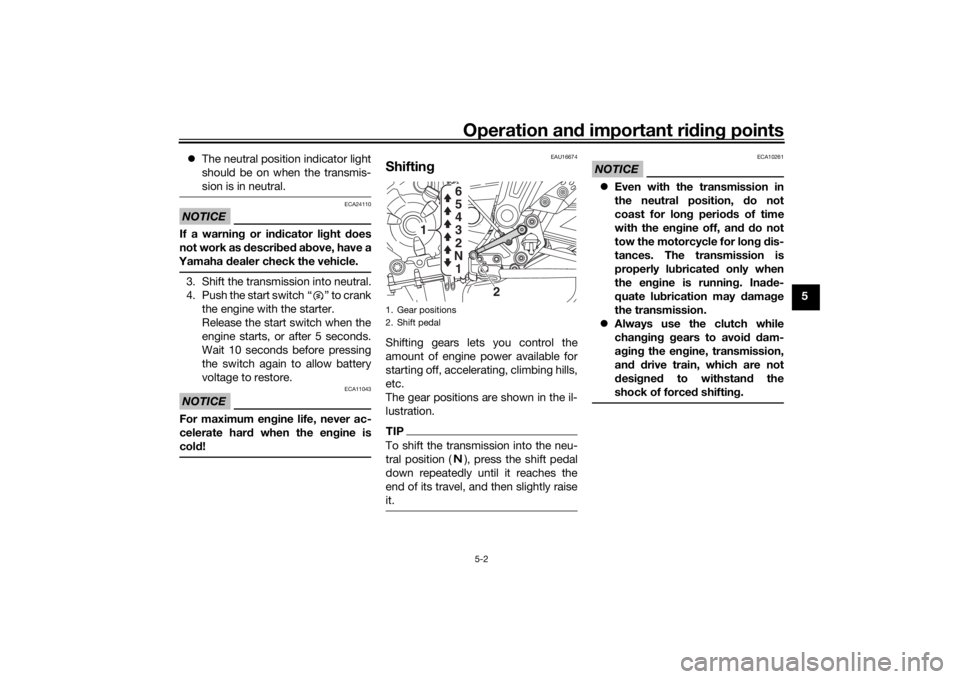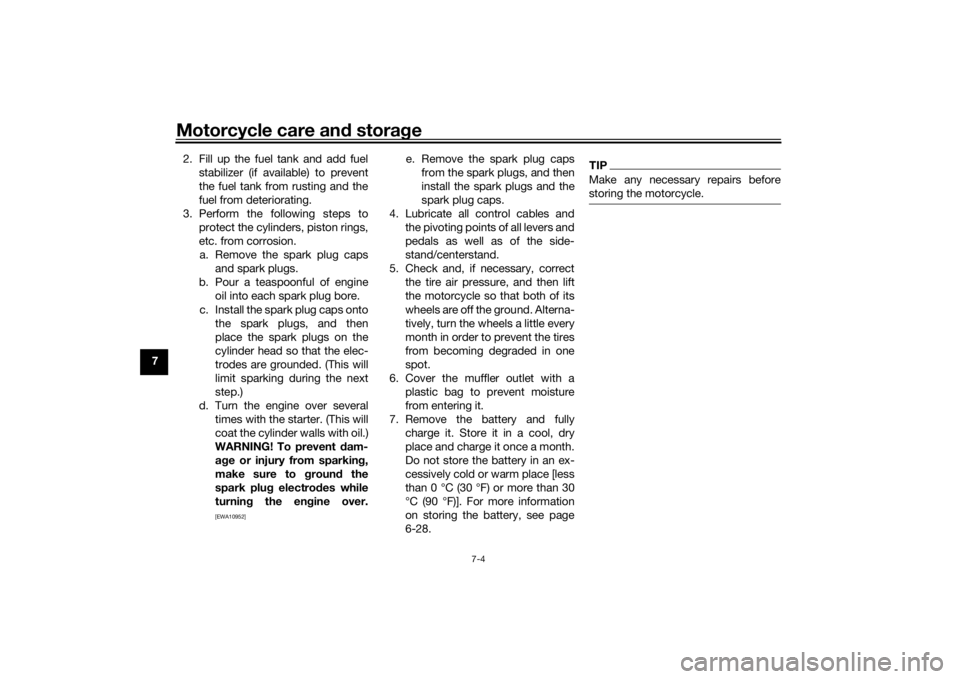battery YAMAHA MT-07 2018 Owners Manual
[x] Cancel search | Manufacturer: YAMAHA, Model Year: 2018, Model line: MT-07, Model: YAMAHA MT-07 2018Pages: 100, PDF Size: 5.44 MB
Page 6 of 100

Table of contentsSafety information ............................ 1-1
Description ....................................... 2-1
Left view ......................................... 2-1
Right view ....................................... 2-2
Controls and instruments ............... 2-3
Instrument an d control functions ... 3-1
Immobilizer system......................... 3-1
Main switch/steering lock............... 3-2
Indicator lights and warning lights............................................ 3-4
Multi-function meter unit ................ 3-6
Handlebar switches ...................... 3-12
Clutch lever .................................. 3-13
Shift pedal .................................... 3-14
Brake lever.................................... 3-14
Brake pedal .................................. 3-14
ABS .............................................. 3-15
Fuel tank cap ................................ 3-16
Fuel ............................................... 3-16
Fuel tank overflow hose ............... 3-18
Catalytic converter ....................... 3-19
Seats ............................................ 3-19
Helmet holding cable.................... 3-21
Storage compartment .................. 3-22
Adjusting the shock absorber assembly ................................... 3-23
Luggage strap holders ................. 3-24
Auxiliary DC connector ................. 3-25
Sidestand ..................................... 3-25 Ignition circuit cut-off system ....... 3-26
For your safety – pre-operation
checks ............................................... 4-1
Operation an d important ri din g
points ................................................. 5-1
Starting the engine .......................... 5-1
Shifting ............................................ 5-2
Tips for reducing fuel consumption ................................ 5-3
Engine break-in ............................... 5-3
Parking ............................................ 5-4
Perio dic maintenance an d
a d justment ........................................ 6-1
Tool kit ............................................ 6-2
Periodic maintenance charts .......... 6-3
Periodic maintenance chart for the emission control system .............. 6-3
General maintenance and lubrication chart ........................... 6-4
Checking the spark plugs ............... 6-8
Canister .......................................... 6-9
Engine oil and oil filter cartridge...... 6-9
Coolant.......................................... 6-12
Replacing the air filter element
and cleaning the check hose..... 6-14
Checking the throttle grip free
play ............................................ 6-14
Valve clearance ............................. 6-15 Tires .............................................. 6-15
Cast wheels .................................. 6-17
Adjusting the clutch lever free
play ............................................ 6-18
Checking the brake lever free
play ............................................ 6-18
Brake light switches ..................... 6-19
Checking the front and rear brake pads ................................ 6-19
Checking the brake fluid level ...... 6-20
Changing the brake fluid .............. 6-21
Drive chain slack........................... 6-22
Cleaning and lubricating the drive chain ................................. 6-23
Checking and lubricating the cables ........................................ 6-24
Checking and lubricating the
throttle grip and cable ............... 6-24
Checking and lubricating the brake and shift pedals............... 6-25
Checking and lubricating the brake and clutch levers ............. 6-25
Checking and lubricating the
sidestand................................... 6-26
Lubricating the swingarm pivots......................................... 6-26
Checking the front fork ................. 6-27
Checking the steering................... 6-27
Checking the wheel bearings ....... 6-28
Battery .......................................... 6-28
Replacing the fuses ...................... 6-29UB4CE0E0.book Page 1 Monday, December 11, 2017 3:53 PM
Page 14 of 100

Description
2-2
2
EAU10421
Right view
3
5
2
1
6
7 4
1. Fuses (page 6-29)
2. Battery (page 6-28)
3. Spring preload adjuster (page 3-23)
4. Fuel tank cap (page 3-16)
5. Headlight (page 6-31)
6. Brake pedal (page 3-14)
7. Rear brake fluid reservoir (page 6-20)UB4CE0E0.book Page 2 Monday, December 11, 2017 3:53 PM
Page 18 of 100

Instrument and control functions
3-3
3
EAU1068B
LOCK
The steering is locked and all electrical
systems are off. The key can be re-
moved.
To lock the steering1. Turn the handlebars all the way to
the left.
2. With the key in the “OFF” position, push the key in and turn it to
“LOCK”.
3. Remove the key.
TIPIf the steering will not lock, try turning
the handlebars back to the right slight-
ly.To unlock the steeringFrom the “LOCK” position, push the
key in and turn it to “OFF”.
EAU59680
(Parkin g)
The hazard lights and turn signal lights
can be turned on, but all other electri-
cal systems are off. The key can be re-
moved.
The steering must be locked before the
key can be turned to “ ”.
NOTICE
ECA20760
Usin g the hazar d o r tu r n s i gnal li ghts
for an exten ded len gth of time may
cause the battery to dischar ge.
1. Push.
2. Turn.12
1. Push.
2. Turn.12
UB4CE0E0.book Page 3 Monday, December 11, 2017 3:53 PM
Page 47 of 100

Operation and important ri din g points
5-2
5
The neutral position indicator light
should be on when the transmis-
sion is in neutral.
NOTICE
ECA24110
If a warnin g or in dicator li ght does
not work as d escribed a bove, have a
Yamaha dealer check the vehicle.3. Shift the transmission into neutral.
4. Push the start switch “ ” to crank
the engine with the starter.
Release the start switch when the
engine starts, or after 5 seconds.
Wait 10 seconds before pressing
the switch again to allow battery
voltage to restore.NOTICE
ECA11043
For maximum en gine life, never ac-
celerate har d when the en gine is
col d!
EAU16674
Shiftin gShifting gears lets you control the
amount of engine power available for
starting off, accelerating, climbing hills,
etc.
The gear positions are shown in the il-
lustration.TIPTo shift the transmission into the neu-
tral position ( ), press the shift pedal
down repeatedly until it reaches the
end of its travel, and then slightly raise
it.
NOTICE
ECA10261
Even with the transmission in
the neutral position, d o not
coast for lon g period s of time
with the en gine off, an d d o not
tow the motorcycle for lon g d is-
tances. The transmission is
properly lu bricated only when
the en gine is runnin g. Ina de-
quate lu brication may d amage
the transmission.
Always use the clutch while
chan gin g g ears to avoi d d am-
a g in g the en gine, transmission,
an d d rive train, which are not
d esi gne d to withstan d the
shock of force d shiftin g.
1. Gear positions
2. Shift pedal
2
1
1
N 2 3
4
5
6
UB4CE0E0.book Page 2 Monday, December 11, 2017 3:53 PM
Page 77 of 100

Periodic maintenance an d a djustment
6-28
6
EAU23292
Checkin g the wheel bearin gsThe front and rear wheel bearings must
be checked at the intervals specified in
the periodic maintenance and lubrica-
tion chart. If there is play in the wheel
hub or if the wheel does not turn
smoothly, have a Yamaha dealer
check the wheel bearings.
EAU50212
BatteryThe battery is located under the rider
seat. (See page 3-19.)
This model is equipped with a VRLA
(Valve Regulated Lead Acid) battery.
There is no need to check the electro-
lyte or to add distilled water. However,
the battery lead connections need to
be checked and, if necessary, tight-
ened.
WARNING
EWA10761
Electrolyte is poisonous an d
d an gerous since it contains sul-
furic aci d, which causes severe b
urns. Avoi d any contact with
skin, eyes or clothin g an d al-
ways shiel d your eyes when
workin g near b atteries. In case
of contact, ad minister the fol-
lowin g FIRST AID.
EXTERNAL: Flush with plenty of water.
INTERNAL: Drink lar ge quan-
tities of water or milk an d im-
me diately call a physician.
EYES: Flush with water for 15 minutes an d seek prompt
me dical attention.
Batteries pro duce explosive hy-
d ro gen gas. Therefore, keep
sparks, flames, ci garettes, etc.,
away from the battery an d pro-
vi de sufficient ventilation when
char gin g it in an enclose d
space.
KEEP THIS AND ALL BATTER-
IES OUT OF THE REACH OF
CHILDREN.
To char ge the b attery
Have a Yamaha dealer charge the bat-
tery as soon as possible if it seems to
have discharged. Keep in mind that the
1. Battery
2. Negative battery lead (black)
3. Positive battery lead (red)
2
1
3
UB4CE0E0.book Page 28 Monday, December 11, 2017 3:53 PM
Page 78 of 100

Periodic maintenance an d a djustment
6-29
6 battery tends to discharge more quick-
ly if the vehicle is equipped with op-
tional electrical accessories.
NOTICE
ECA16522
To char
ge a VRLA (Valve Re gulate d
Lea d Aci d) battery, a special (con-
stant-volta ge) battery char ger is re-
quire d. Usin g a conventional battery
char ger will damag e the b attery.To store the b attery
1. If the vehicle will not be used for more than one month, remove the
battery, fully charge it, and then
place it in a cool, dry place.
NOTICE: When removin g the
b attery, be sure to turn the main
switch off, then disconnect the
ne gative lea d before discon-
nectin g the positive lea d.
[ECA16304]
2. If the battery will be stored for
more than two months, check it at
least once a month and fully
charge it if necessary.
3. Fully charge the battery before in- stallation. NOTICE: When install-
in g the b attery, be sure to turn
the main switch off, then con- nect the positive lead
before
connectin g the ne gative lea d.
[ECA16842]
4. After installation, make sure that
the battery leads are properly con-
nected to the battery terminals.NOTICE
ECA16531
Always keep the b attery charged .
Storin g a d ischar ged battery can
cause permanent battery damag e.
EAU59872
Replacin g the fusesThe main fuse and the fuse boxes,
which contain the fuses for the individ-
ual circuits, are located under the rider
seat. (See page 3-19.)TIPTo access the main fuse, remove the
starter relay cover as shown.1. Starter relay cover
2. Fuse box
3. Spare main fuse
4. Main fuse
2
3
4
1
UB4CE0E0.book Page 29 Monday, December 11, 2017 3:53 PM
Page 85 of 100

Periodic maintenance an d a djustment
6-36
6
EAU42365
Trou bleshootin g chartsStartin g prob lems or poor en gine performance
Check the fuel level in
the fuel tank.1. Fuel
There is enough fuel.
There is no fuel.
Check the battery.
Supply fuel.
The engine does not start.
Check the battery.
Remove the spark plugs
and check the electrodes.3. Ignition
Wipe off with a dry cloth and correct the
spark plug gaps, or replace the spark plugs.
Have a Yamaha dealer check the vehicle.
Operate the electric starter.4. Compression
There is compression.
There is no compression.
The engine does not start.
Have a Yamaha dealer check the vehicle.Have a Yamaha dealer check the vehicle.
The engine does not start.
Check the compression.
Operate the electric starter.2. Battery
The engine turns over
quickly.
The engine turns over
slowly.
The engine does not start.
Check the ignition.
The battery is good.Check the battery lead connections,
and have a Yamaha dealer charge
the battery if necessary.
DryWet
Operate the electric starter.
UB4CE0E0.book Page 36 Monday, December 11, 2017 3:53 PM
Page 90 of 100

Motorcycle care and stora ge
7-4
7 2. Fill up the fuel tank and add fuel
stabilizer (if available) to prevent
the fuel tank from rusting and the
fuel from deteriorating.
3. Perform the following steps to protect the cylinders, piston rings,
etc. from corrosion.a. Remove the spark plug caps and spark plugs.
b. Pour a teaspoonful of engine oil into each spark plug bore.
c. Install the spark plug caps onto the spark plugs, and then
place the spark plugs on the
cylinder head so that the elec-
trodes are grounded. (This will
limit sparking during the next
step.)
d. Turn the engine over several times with the starter. (This will
coat the cylinder walls with oil.)
WARNING! To prevent d am-
a g e or injury from sparkin g,
make sure to groun d the
spark plu g electro des while
turnin g the en gine over.
[EWA10952]
e. Remove the spark plug caps
from the spark plugs, and then
install the spark plugs and the
spark plug caps.
4. Lubricate all control cables and the pivoting points of all levers and
pedals as well as of the side-
stand/centerstand.
5. Check and, if necessary, correct the tire air pressure, and then lift
the motorcycle so that both of its
wheels are off the ground. Alterna-
tively, turn the wheels a little every
month in order to prevent the tires
from becoming degraded in one
spot.
6. Cover the muffler outlet with a plastic bag to prevent moisture
from entering it.
7. Remove the battery and fully charge it. Store it in a cool, dry
place and charge it once a month.
Do not store the battery in an ex-
cessively cold or warm place [less
than 0 °C (30 °F) or more than 30
°C (90 °F)]. For more information
on storing the battery, see page
6-28.
TIPMake any necessary repairs before
storing the motorcycle.
UB4CE0E0.book Page 4 Monday, December 11, 2017 3:53 PM
Page 92 of 100

Specifications
8-2
8
6th:0.964 (27/28)
Chassis:Frame type:
Diamond
Caster angle: 24.8 °
Trail: 90 mm (3.5 in)Front tire:Type:Tubeless
Size: 120/70 ZR 17M/C(58W)
Manufacturer/model:
MICHELIN/PILOT ROAD 4
Manufacturer/model: BRIDGESTONE/BT023F FRear tire:Type:
Tubeless
Size: 180/55 ZR 17M/C(73W)
Manufacturer/model: MICHELIN/PILOT ROAD 4
Manufacturer/model:
BRIDGESTONE/BT023R MLoa din g:Maximum load:
172 kg (379 lb)
(Total weight of rider, passenger, cargo
and accessories)
Tire air pressure (measure d on col d
tires):1 person:
Front: 225 kPa (2.25 kgf/cm², 33 psi)
Rear:
250 kPa (2.50 kgf/cm², 36 psi)
2 persons: Front:
225 kPa (2.25 kgf/cm², 33 psi)
Rear: 250 kPa (2.50 kgf/cm², 36 psi)Front wheel:Wheel type:
Cast wheel
Rim size: 17M/C x MT3.50Rear wheel:Wheel type:
Cast wheel
Rim size: 17M/C x MT5.50Front brake:Type:
Hydraulic dual disc brake
Specified brake fluid: DOT 4Rear brake:Type:
Hydraulic single disc brake
Specified brake fluid: DOT 4
Front suspension:Type:Telescopic fork
Spring:
Coil spring
Shock absorber: Hydraulic damper
Wheel travel: 130 mm (5.1 in)Rear suspension:Type:Swingarm (link suspension)
Spring: Coil spring
Shock absorber:
Gas-hydraulic damper
Wheel travel: 130 mm (5.1 in)Electrical system:System voltage:
12 V
Ignition system: TCI
Charging system: AC magnetoBattery:Model:YTZ10S
Voltage, capacity: 12 V, 8.6 Ah (10 HR)Hea dlig ht:Bulb type:
Halogen bulb
UB4CE0E0.book Page 2 Monday, December 11, 2017 3:53 PM
Page 96 of 100

10-1
10
IndexAABS ....................................................... 3-15
ABS warning light ................................... 3-5
Air filter element and check hose,
replacing and cleaning ....................... 6-14
Auxiliary DC connector ......................... 3-25
Auxiliary light bulb, replacing ................ 6-32BBattery .................................................. 6-28
Brake and clutch levers, checking and lubricating ........................................... 6-25
Brake and shift pedals, checking and
lubricating ........................................... 6-25
Brake fluid, changing ............................ 6-21
Brake fluid level, checking .................... 6-20
Brake lever ............................................ 3-14
Brake lever free play, checking............. 6-18
Brake light switches.............................. 6-19
Brake pedal........................................... 3-14
Brake/tail light ....................................... 6-33CCables, checking and lubricating ......... 6-24
Canister................................................... 6-9
Care ........................................................ 7-1
Catalytic converter ................................ 3-19
Clutch lever ........................................... 3-13
Clutch lever free play, adjusting ........... 6-18
Coolant ................................................. 6-12
Coolant temperature warning light ......... 3-4DData recording, vehicle ........................... 9-2
Diagnostic connector.............................. 9-2
Dimmer switch ...................................... 3-13
Drive chain, cleaning and lubricating .... 6-23 Drive chain slack .................................. 6-22
EEngine break-in ...................................... 5-3
Engine oil and oil filter
cartridge ............. 6-9
Engine serial number .............................. 9-1
Engine trouble warning light ................... 3-5FFront and rear brake pads, checking ... 6-19
Front fork, checking ............................. 6-27
Fuel ....................................................... 3-16
Fuel consumption, tips for reducing ...... 5-3
Fuel tank cap ........................................ 3-16
Fuel tank overflow hose ....................... 3-18
Fuses, replacing ................................... 6-29HHandlebar switches .............................. 3-12
Hazard switch....................................... 3-13
Headlight bulb, replacing ..................... 6-31
Helmet holding cable ........................... 3-21
High beam indicator light ....................... 3-4
Horn switch .......................................... 3-13IIdentification numbers ............................ 9-1
Ignition circuit cut-off system ............... 3-26
Immobilizer system ................................ 3-1
Immobilizer system indicator light .......... 3-5
Indicator lights and warning lights ......... 3-4LLicense plate light bulb, replacing........ 6-34
Luggage strap holders ......................... 3-24MMain switch/steering lock....................... 3-2
Maintenance and lubrication, periodic ... 6-4 Maintenance, emission control
system ..................................................6-3
Matte color, caution ................................7-1
Model label .............................................9-1
Multi-function meter unit .........................3-6
NNeutral indicator light ..............................3-4OOil pressure warning light .......................3-4PParking ....................................................5-4
Part locations ..........................................2-1
Pass switch ...........................................3-13SSafety information ...................................1-1
Seats .....................................................3-19
Shifting ....................................................5-2
Shift pedal .............................................3-14
Shock absorber assembly, adjusting ....3-23
Sidestand ..............................................3-25
Sidestand, checking and lubricating.....6-26
Spark plugs, checking ............................6-8
Specifications .........................................8-1
Start/Engine stop switch .......................3-13
Starting the engine ..................................5-1
Steering, checking ................................6-27
Storage ...................................................7-3
Storage compartment ...........................3-22
Supporting the motorcycle ...................6-35
Swingarm pivots, lubricating ................6-26TThrottle grip and cable, checking and lubricating ...........................................6-24
Throttle grip free play, checking ...........6-14
UB4CE0E0.book Page 1 Monday, December 11, 2017 3:53 PM